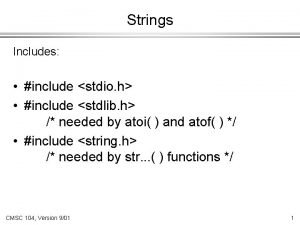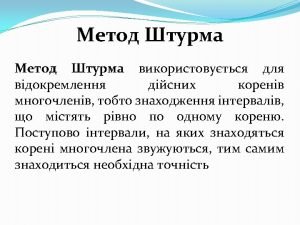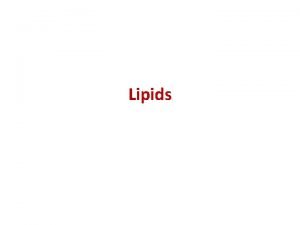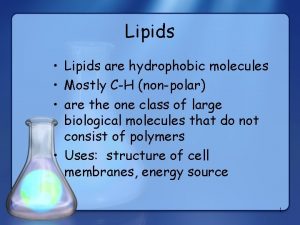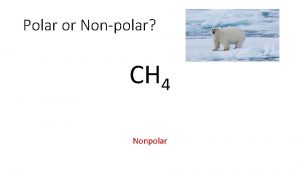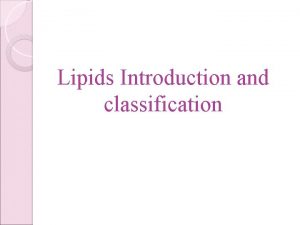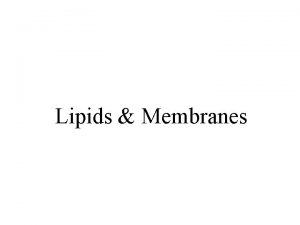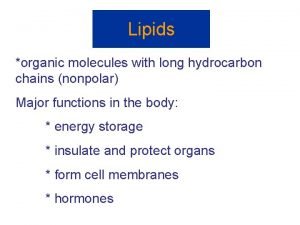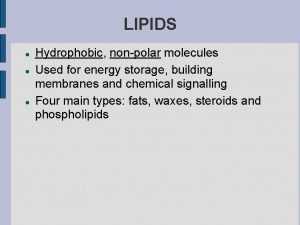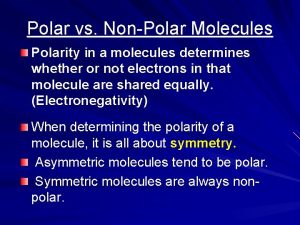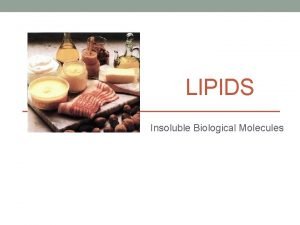Lipids Lipids Lipids are nonpolar molecules that include












- Slides: 12

Lipids

Lipids • Lipids are nonpolar molecules that include fats, oils, and cholesterol. – Many contain carbon chains called fatty acids. – Fats and oils contain fatty acids bonded to glycerol. – Made of C, H, O – Building Blocks: 1 glycerol and 3 fatty acids – Most important lipids are fats, phospholipids and steroids

Dehydration Synthesis Fatty Acid Gylcerol

Dehydration Synthesis TRIGYLCERIDE

• Fatty acids will very in length (number of carbons) and the number and location of single and double bonds • Saturated fatty acids have a higher number of hydrogens and NO DOUBLE BONDS • Unsaturated fatty acids have ONE OR MORE DOUBLE BONDS

• Saturated fats are solid at room temperature • Mostly animal fats • A diet rich in these fats can lead to cardiovascular disease

• Unsaturated fats are liquid at room temperature • Plants and fish fats are examples

• Lipids have several different functions. – broken down as a source of energy – make up cell membranes • used to make hormones

• As an energy source fats can be broken down • Release a lot of energy however it takes a high amount of energy to break down 1 fat molecule • Humans and other animals store their fat as ADIPOSE CELLS • ADIPOSE TISSUE also cushions vital organs and insulates the body

• Phospholipids are two fatty acids and a phosphate group attached to a glycerol • Main structural component of cell membranes

Arrangement of Phospholipids

• Steroids are lipids characterized by a carbon skeleton consisting of four fused rings • Cholesterol, an important steroid, is a component in animal cell membranes • Although cholesterol is essential in animals, high levels in the blood may contribute to cardiovascular disease
 Antigentest åre
Antigentest åre Polar and nonpolar similarities
Polar and nonpolar similarities Substance leds shape polarity
Substance leds shape polarity #include stdio.h #include stdlib.h #include string.h
#include stdio.h #include stdlib.h #include string.h #include stdio.h #include conio.h #include stdlib.h
#include stdio.h #include conio.h #include stdlib.h Nonpolar lipids
Nonpolar lipids Organic molecules vs inorganic molecules
Organic molecules vs inorganic molecules Non polar molecules that include fats oils and cholesterol
Non polar molecules that include fats oils and cholesterol Thơ thất ngôn tứ tuyệt đường luật
Thơ thất ngôn tứ tuyệt đường luật Gây tê cơ vuông thắt lưng
Gây tê cơ vuông thắt lưng Phân độ lown
Phân độ lown



